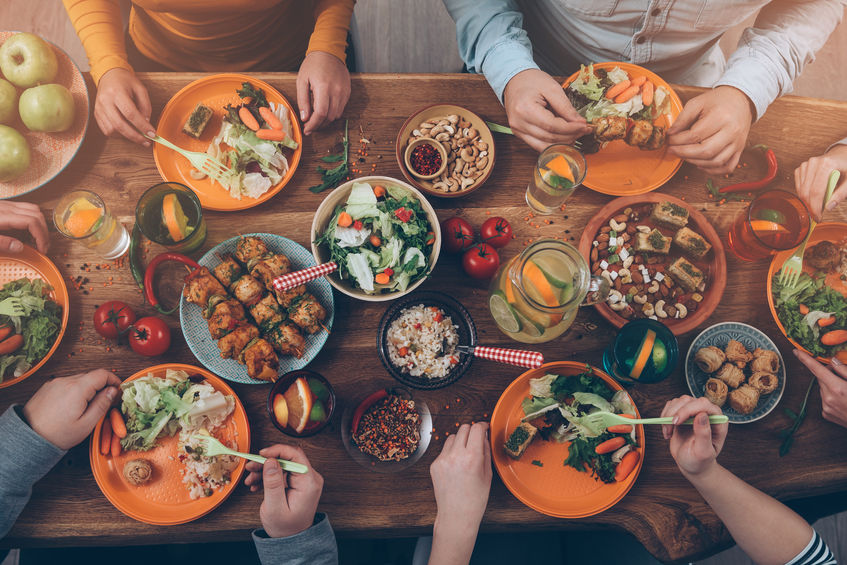Think Outside the U.S. for your Meal Inspiration
As a dietitian, I frequently provide my clients with meal ideas. Now with pinterest, blogs, food magazines, etc. it’s really quite simple to find options. One thing I’ve noticed, however, is that many of the same recipes (or variations of the same) pop up over and over. Maybe we’re all in need of a little inspiration! Since last week when I discussed the Okinawan culture and explored some of the nutritious foods that are part of their everyday diet, I decided to explore other cultural foods.
Balance and variety are two key components to a healthy diet. When we consume the same variations of dishes, not only do we get bored with our food, but we also deprive our body of different types of nutrients that are featured in signature dishes of other cultures.
I’ve chosen several national dishes from different regions that contain very nutrient-dense ingredients. Instead of your “go-to” meals options, give these a try.

Try Meals from Different Cultures!
Borshch/ Borscht
Craving soup/stew? Perhaps you’re tired of chicken stew and butternut squash soup has lost its novelty. Have you considered beet soup (I’m serious!)? Though Borshch is a signature dish claimed by both Russians and Ukrainians, you’ll find different versions all over. Historically, borshch was the national food in Ancient Rome, where cabbages and beets were specifically cultivated for that purpose. Yet, many sources suggest that the version of borshch widely known today first appeared around the 15th century. There are several legends about its origin. One claims that the first-ever borshch was cooked by the Cossacks in 1637 during a two-month siege of the Azov fortress in Southern Russia. Out of necessity to feed all the men at camp, they collected anything edible that could be found and combined it into what is now borscht. The other belief is that the name came either from the plant borshchevik – one of the key ingredients of the older-time borshch, or from the Old Slavonic word for “beet” (brshch). Whatever you choose to believe, this is an easy way to get your veggies in since it’s packed with beets, cabbage, and carrots. Even if you’re only concerned about finding a new option to wow your family with, I am obligated to let you know the nutritional benefits that you’re getting! Beetroot is a good source of B-complex vitamins such as niacin (B-3), pantothenic acid (B-5), pyridoxine (B-6) and minerals such as iron, manganese, copper, magnesium and a small amount of potassium. What’s really impressive is that the root is rich source of phytochemical compound, glycine betaine. This helps cardiovascular function by reducing homocytseine levels. High homocysteine is linked to coronary heart disease. Eat up for heart health! Carrots pack Vitamin A, which is essential for vision and cabbage contains powerful compounds that assists the body’s natural detoxification process.
You can make it vegetarian for a light appetizer or add potatoes and meat to for a hearty meal.
Try this budget-friendly recipe from Natashaskitchen.com
Prep time: 30 mins
Cook time: 1 hour 30 mins
Total time: 2 hours
Serve hot with fresh sprigs of parsley or dill and a dollop of sour cream if desired.
Author: Natasha of NatashasKitchen.com
Skill Level: Medium
Cost To Make: $9-$12
Serving: 8-10
Ingredients
- 1 lb Beef: sirloin, stew meat, or whatever kind of beef you like, really (bone-in or boneless *see note)
- 1 Tbsp salt + more to taste
- 2 large or 3 medium beets, washed, peeled and grated
- 4 Tbsp olive oil
- 1 Tbsp vinegar
- 1 Tbsp sugar
- 2 Tbsp tomato sauce, or paste (or 3 Tbsp ketchup)
- 1 Tbsp butter
- 1 medium onion, finely diced
- 2 carrots, grated
- 2 large or 3 medium potatoes, peeled and sliced into bite-sized pieces
- ½ head of small cabbage, sliced
- 2 tomatoes, peeled and diced (**see note)
- 2 bay leaves
- ¼ tsp freshly ground pepper
- ¼ cup chopped fresh parsley + more for garnish
- 2 cloves garlic, pressed
- Garnish: Sour cream and fresh sprigs of parsley or dill.
Instructions
- Wash meat in cold water, cut into 1″ pieces and and place in a large soup pot with 14 cups cold water and 1 Tbsp salt. Bring it to a boil and remove the foam crud as soon as it boils (if you wait, it will be hard to get rid of the crud as it integrates into the broth and you’d have to strain it later). Reduce heat, partially cover and simmer 45 minutes – 1 hr, periodically skimming off any crud that rises to the top.
- Grate beets on the large grater holes (a food processor works amazingly well). Place them in a large heavy-bottom skillet with 4 Tbsp olive oil and 1 Tbsp vinegar and saute for 5 minutes, then reduce heat to med/low and add 1 Tbsp sugar and 2 Tbsp tomato sauce Mix thoroughly and saute until starting to soften, stirring occasionally (about 10 min). Remove from pan and set aside.
- In the same skillet (no need to wash it), Saute onion in 1 Tbsp butter for 2 min. Add grated carrot and sautee another 5 min or until softened, adding more oil if it seems too dry.
- Once the meat has been cooking at least 45 min, place sliced potatoes into
- the soup pot and cook 10 min, then add cabbage, sauteed beets, onion & carrot, and chopped tomatoes. Cook another 10 minutes or until potatoes can be easily pierced with a fork.
- Add 2 bay leaves, ¼ tsp pepper, and more salt to taste (I added another ½ tsp salt).
- Chop parsley and pressed garlic then stir them into the soup pot, immediately cover and remove from heat. Let the pot rest covered for 20 minutes for the flavors to meld.
Notes
*Pork can be used also. And if your meat has a bone in it, place it in the water whole. After it boils for 45 min to 1 hour, remove it from soup, cut away and discard the bone and cut meat into 1″ pieces).
**To peel whole tomatoes, blanch them in boiling hot water for 30-45 seconds, then transfer to cold water and the skin should peel right off.
Injera
Are you tired of the tried-and-true brown rice or potato with your meal? Ditch those, along with your eating utensils, and have injera instead! In Ethiopia and Eritrea, this spongy, sour flatbread is used in lieu of a fork or spoon to scoop up meat and vegetable stews. Traditionally, injera also lines the tray on which the stews are served, allowing it to soak up the delicious juices. Made from teff flour, it is a naturally gluten free carbohydrate source that is said to be responsible for the health and vigor of Ethiopian runners. Teff is a highly nutritious ancient grain that has grown in Ethiopia for thousands of years. It is rich in fiber and protein. Compared to other grains, teff is much higher in calcium and is also a very good source of iron.
What makes injera different from other flatbreads is that it’s actually allowed to ferment, giving it a slightly “sour” or tart taste. I’ve made it at home and it’s quite simple! Teff flour can be found in most regular grocery stores in the aisle with other gluten free flours. Incorporate this nutritious grain as an excellent complex carbohydrate source. If you want to go all out, serve with Doro Wat, a signature Ethiopian chicken stew.
INJERA BREAD
Makes 10 flatbreads
INGREDIENTS
- 1 ½ cups ground teff flour
- 2 cups water
- salt to taste
- oil for the skillet (coconut or avocado oil are good for high-heat cooking, vegetable can be used too)
DIRECTIONS
- Mix ground teff with the water and let stand in a bowl covered with a dish towel at room temperature until it bubbles and has turned sour; This may take as long as 3 days, although I had success with an overnight fermentation; The fermenting mixture should be the consistency of a very thin pancake batter.
- Stir in the salt, a little at a time, until you can barely detect its taste.
- Lightly oil an 8 or 9 inch skillet (or a larger one if you like); Heat over medium heat.
- Pour in enough batter to cover the bottom of the skillet; About 1/4 cup will make a thin pancake covering the surface of an 8 inch skillet if you spread the batter around immediately by turning and rotating the skillet in the air; This is the classic French method for very thin crepes; Injera is not supposed to be paper thin so you should use a bit more batter than you would for crepes, but less than you would for a flapjack pancakes.
- Cook briefly, until holes form in the injera and the edges lift from the pan; Do not let it brown, and don’t flip it over as it is only supposed to be cooked on one side.
- Remove and let cool. Place plastic wrap or foil between successive pieces so they don’t stick together.
- To serve, lay one injera on a plate and ladle your chosen dishes on top (e.g., a lovely doro wat or alicha). Serve additional injera on the side. Guests can be instructed to eat their meal without utensils, instead using the injera to scoop up their food.
Feijoada
If you like black beans, you must try this Brazilian national dish. There are countless varieties throughout the country using different types of meats. The name comes from the Portuguese word feijão, meaning ‘beans’, which is fitting because the dish is essentially a stew consisting of black beans with smoked beef and pork. Traditional feijoada utilizes less expensive parts of the pig, which include the ears, feet, and tails. You might know that black beans provide fiber, which aids in regularity but Recent research has shown that black beans are superior to other beans/legumes (lentils and chickpeas) regarding digestive health, particularly for the colon. A 1-cup serving provides approximately 60% of your fiber and folate needs. This is also a great way to get approximately 40% of lesser known, but very important minerals: copper and manganese. Copper works with iron to form red blood cells. It is also needed to healthy bones, immune system and blood vessels. Manganese assists in fat and carbohydrate metabolism, calcium absorption, and blood sugar regulation. It is also needed for normal brain and nerve function.
Most often, feijoada is served with rice, Brazilian collard greens, and topped with farofa (toasted cassava flour). This meal provides protein, complex carbs, fiber and vegetables! Make it healthier by having brown rice instead of white. This is a meal that freezes well (recipe here), so make a large batch and use it as a quick dinner on a busy evening.
Labneh
Though cream cheese on a bagel certainly tastes delicious, it is high in saturated fat and has little protein to keep you satisfied. Thankfully, you have an alternative. Labneh, a Middle Eastern cheese, is made by straining salted yogurt. Through the straining process, good portions of sugars/carbohydrates are removed, while protein remains. Labneh is also rich in probiotics and calcium. Probiotics are healthy bacteria that help combat harmful microorganisms, enhance digestion and nutrient absorption, and contribute to immune function. Calcium is known to assist in bone health, but studies show that it might also contribute to protection against cancer, high blood pressure, and diabetes.
It is traditionally served with olive oil as a dip for pita bread and/or veggies and also is frequently accompanied by figs and honey on toast as a delicious breakfast. It can be found in Middle Eastern grocery stores or you can make it yourself (recipe here)! If you don’t want to have it on your whole grain toast for breakfast, serve it as a dip as an excellent vessel for vegetables ☺
I haven’t even begun to broach the surface when it comes to food variety from various cultures. I’ll bring you more cultural dishes that pack a nutritional punch, but until then, try these out!
Resources:
http://www.ancientgrains.com/teff-history-and-origin/
https://ethiopianfood.wordpress.com/2011/11/25/culinary-milestones-an-appetizing-history/
http://www.food.com/recipe/authentic-injera-aka-ethiopian-flat-bread-96980
http://www.health.harvard.edu/vitamins-and-supplements/health-benefits-of-taking-probiotics
http://www.nutrition-and-you.com/beets.html
http://www.nutrizonia.com/how-to-make-labneh-fermented-yogurt-spread/
http://www.nytimes.com/health/guides/nutrition/copper-in-diet/overview.html
http://www.myjewishlearning.com/the-nosher/making-your-own-labneh/
http://www.smithsonianmag.com/arts-culture/Celebrate-Brazil-with-Emerils-Feijoada-180951699/?no-ist











